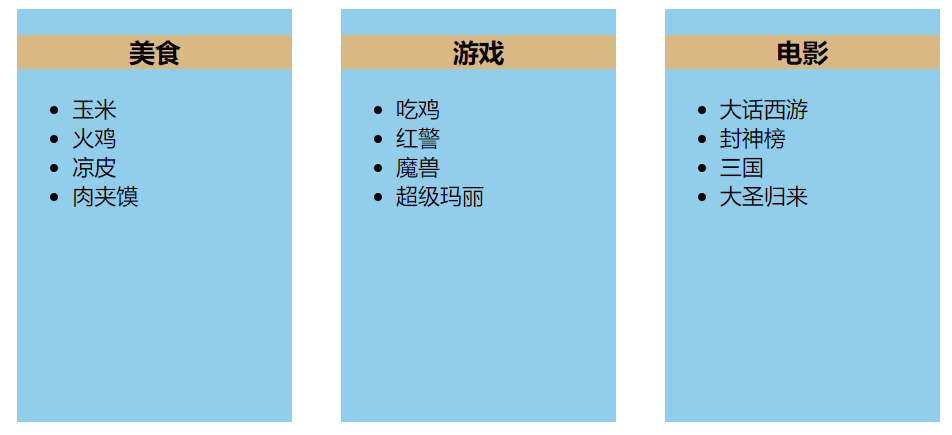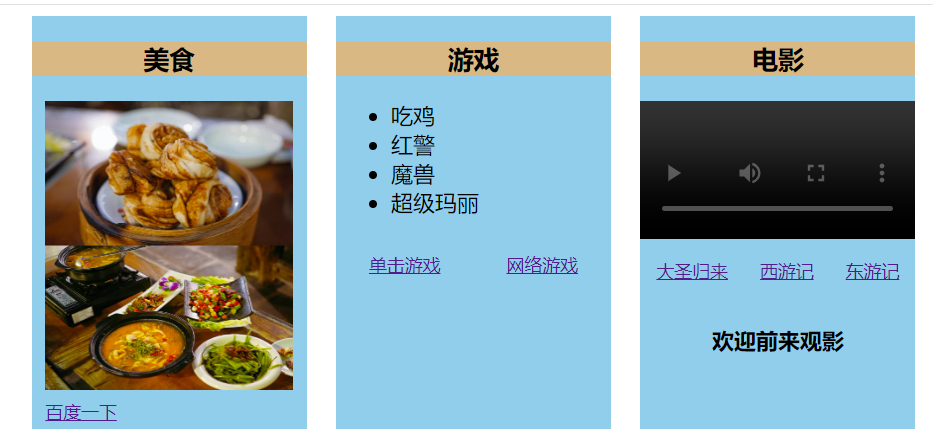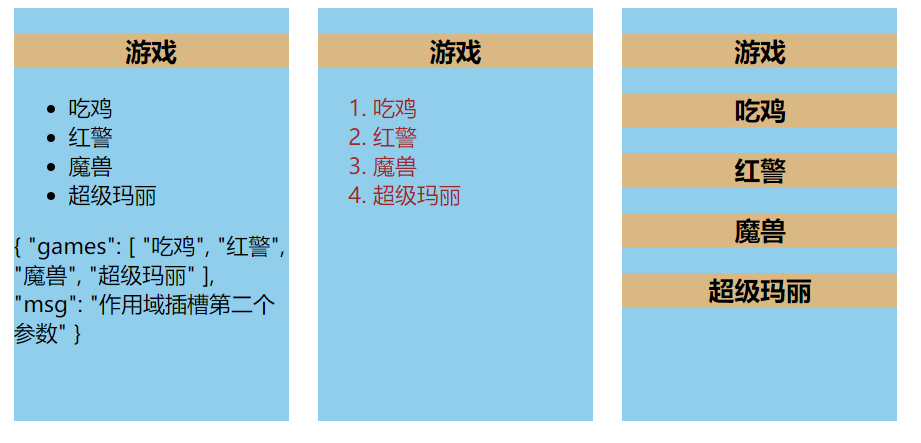插槽总结:
- 作用:让父组件可以向子组件指定位置插入html结构,也是一种组件之间通信的方式,适用于--父组件==》子组件。
- 分类:默认插槽、具名插槽、作用域插槽
- 使用方式
- 默认插槽
-
父组件中: <Category> <div>html结构</div> </Category> 子组件中: <template> <div> <!-- 定义插槽,等待组件的使用者使用 --> <slot>插槽默认内容</slot> </div> </template>
-
- 具名插槽
-
-
父组件中: <Category> <template slot="center"> <div>html结构1</div> </template> <template v-slot="footer"> <div>html结构2</div> </template> </Category> 子组件中: <template> <div> <!-- 定义插槽,等待组件的使用者使用 --> <slot name="center">插槽默认内容</slot>
<slot name="footer">插槽默认内容</slot>
</div>
</template>
-
-
- 作用域插槽
- 理解:数据在组件的自身,但根据数据生成的结构需要组件的使用者来决定(games数据在Category组件中,但使用数据所遍历出来的结构由App组件决定)
- 具体编码:
-
<template> <div class="app"> <!-- 写法一 --> <Category title="游戏"> <template scope="mygame"> <!-- 我这就可以获取到对象了,里面包含Category.vue中的games对象哦 --> <!-- {{mygame}} --> <ul> <li v-for="(item,index) in mygame.games" :key="index">{{item}}</li> </ul> {{mygame}} </template> </Category> <!-- 写法二 --> <Category title="游戏"> <template scope="{games}"> <ol> <li v-for="(item,index) in games" style="color: brown;" :key="index">{{item}}</li> </ol> </template> </Category> <!-- 写法三 --> <Category title="游戏"> <template slot-scope="{games}"> <h3 v-for="(item,index) in games" :key="index">{{item}}</h3> </template> </Category> </div> </template> <script
-
- 默认插槽
vue默认插槽
示例一:不使用插槽
Category.vue
<template>
<div class="category">
<h3>{{title}}</h3>
<ul>
<li v-for="(item,index) in listData"
:key="index">{{item}}</li>
</ul>
</div>
</template>
<script>
export default {
name: 'Category',
props: ['listData', 'title'],
}
</script>
<style>
.category {
background-color: skyblue;
width: 200px;
height: 300px;
}
h3 {
text-align: center;
background-color: burlywood;
}
</style>
App.vue
<template>
<div class="app">
<Category title="美食"
:listData="foods" />
<Category title="游戏"
:listData="games" />
<Category title="电影"
:listData="films" />
</div>
</template>
<script>
// 引入组件
import Category from './components/Category.vue';
export default {
name: 'App',
components: { Category },
data () {
return {
foods: ['玉米', '火鸡', '凉皮', '肉夹馍'],
games: ['吃鸡', '红警', '魔兽', '超级玛丽'],
films: ['大话西游', '封神榜', '三国', '大圣归来'],
msg: '插槽学习喽'
}
},
}
</script>
<style scoped>
.app {
display: flex;
justify-content: space-around;
margin: 5px;
}
</style>

vue默认插槽 slot
示例二:
Category2.vue
<template>
<div class="category">
<h3>{{title}}</h3>
<!-- 定义插槽,等待组件的使用者使用 -->
<slot></slot>
</div>
</template>
<script>
export default {
name: 'Category2',
props: ['title'],
}
</script>
<style scope>
.category {
background-color: skyblue;
width: 200px;
height: 300px;
}
h3 {
text-align: center;
background-color: burlywood;
}
</style>
App.vue
<template>
<div class="app">
<Category title="美食">
<img src="./assets/foods.jpeg"
alt="">
</Category>
<Category title="游戏"
:listData="games">
<ul>
<li v-for="(item,index) in games"
:key="index">{{item}}</li>
</ul>
</Category>
<Category title="电影">
<!-- <img src="./assets/films.jpg"
alt=""> -->
<video controls
src="https://www.bilibili.com/video/BV1LX4y1H7wX/?spm_id_from=333.880.my_history.page.click"></video>
</Category>
</div>
</template>
<script>
// 引入组件
// import Category from './components/Category.vue';
import Category from './components/Category2.vue';
export default {
name: 'App',
components: { Category },
data () {
return {
foods: ['玉米', '火鸡', '凉皮', '肉夹馍'],
games: ['吃鸡', '红警', '魔兽', '超级玛丽'],
films: ['大话西游', '封神榜', '三国', '大圣归来'],
msg: '插槽学习喽'
}
},
}
</script>
<style scoped>
.app {
display: flex;
justify-content: space-around;
margin: 5px;
}
video {
width: 100%;
}
img {
width: 95%;
height: 75%;
margin-left: 5px;
}
</style>

具名插槽:具有名称的插槽
Category.vue
<template>
<div class="category">
<h3>{{title}}</h3>
<!-- 定义插槽,等待组件的使用者使用 -->
<slot name="center">这里是一些默认值,当使用者没有传递具体结构时,会显示这些信息</slot>
<slot name="footer">这里是一些默认值,当使用者没有传递具体结构时,会显示这些信息</slot>
</div>
</template>
<script>
export default {
name: 'Category',
props: ['title'],
}
</script>
<style scoped>
.category {
background-color: skyblue;
width: 200px;
height: 300px;
}
h3 {
text-align: center;
background-color: burlywood;
}
</style>
App.vue
<template>
<div class="app">
<!-- {{msg}} -->
<Category title="美食">
<img src="./assets/foods.jpeg"
slot="center"
alt="">
<a href="https://www.baidu.com/"
slot="footer">百度一下</a>
</Category>
<Category title="游戏"
:listData="games">
<ul slot="center">
<li v-for="(item,index) in games"
:key="index">{{item}}</li>
</ul>
<div slot="footer"
class="footercss">
<a href="https://www.baidu.com/">单击游戏</a>
<a href="https://www.baidu.com/">网络游戏</a>
</div>
</Category>
<Category title="电影">
<!-- <img src="./assets/films.jpg"
alt=""> -->
<video controls
slot="center"
src="https://www.bilibili.com/video/BV1LX4y1H7wX/?spm_id_from=333.880.my_history.page.click"></video>
<!-- 注:slot="footer" 属性 可分别在 每个标签中设置哦 -->
<!-- 第一种写法 建议使用该方式
<template slot="footer">
<div class="footercss">
<a href="https://www.baidu.com/">大圣归来</a>
<a href="https://www.baidu.com/">西游记</a>
<a href="https://www.baidu.com/">东游记</a>
</div>
<h4>欢迎前来观影</h4>
</template> -->
<!-- 第二种写法 v-slot: 只能在template写法 -->
<template v-slot:footer>
<div class="footercss">
<a href="https://www.baidu.com/">大圣归来</a>
<a href="https://www.baidu.com/">西游记</a>
<a href="https://www.baidu.com/">东游记</a>
</div>
<h4>欢迎前来观影</h4>
</template>
</Category>
</div>
</template>
<script>
// 引入组件
import Category from './components/Category.vue';
export default {
name: 'App',
components: { Category },
data () {
return {
foods: ['玉米', '火鸡', '凉皮', '肉夹馍'],
games: ['吃鸡', '红警', '魔兽', '超级玛丽'],
films: ['大话西游', '封神榜', '三国', '大圣归来'],
msg: '具名插槽学习喽==》'
}
},
}
</script>
<style scoped>
.app {
display: flex;
justify-content: space-around;
margin: 5px;
}
.footercss {
display: flex;
justify-content: space-around;
}
video {
width: 100%;
}
img {
width: 90%;
height: 70%;
margin-left: 10px;
}
a {
font-size: 13px;
margin: 10px;
text-align: center;
}
h4 {
text-align: center;
}
</style>

作用域插槽:数据在定义插槽的地方,数据结构在使用的地方
示例三:
Category.vue
<template>
<div class="category">
<h3>{{title}}</h3>
<!-- 定义插槽,等待组件的使用者使用 -->
<slot :games="games"
:msg="msg">这里是一些默认值,当使用者没有传递具体结构时,会显示这些信息</slot>
<!-- <ul>
<li v-for="(item,index) in games"
:key="index">{{item}}</li>
</ul> -->
</div>
</template>
<script>
export default {
name: 'Category',
props: ['title'],
data () {
return {
games: ['吃鸡', '红警', '魔兽', '超级玛丽'],
msg: '作用域插槽第二个参数',
}
},
}
</script>
<style scoped>
.category {
background-color: skyblue;
width: 200px;
height: 300px;
}
h3 {
text-align: center;
background-color: burlywood;
}
</style>
App.vue
<template>
<div class="app">
<!-- 写法一 -->
<Category title="游戏">
<template scope="mygame">
<!-- 我这就可以获取到对象了,里面包含Category.vue中的games对象哦 -->
<!-- {{mygame}} -->
<ul>
<li v-for="(item,index) in mygame.games"
:key="index">{{item}}</li>
</ul>
{{mygame}}
</template>
</Category>
<!-- 写法二 -->
<Category title="游戏">
<template scope="{games}">
<ol>
<li v-for="(item,index) in games"
style="color: brown;"
:key="index">{{item}}</li>
</ol>
</template>
</Category>
<!-- 写法三 -->
<Category title="游戏">
<template slot-scope="{games}">
<h3 v-for="(item,index) in games"
:key="index">{{item}}</h3>
</template>
</Category>
</div>
</template>
<script>
// 引入组件
import Category from './components/Category.vue';
export default {
name: 'App',
components: { Category },
}
</script>
<style scoped>
.app {
display: flex;
justify-content: space-around;
margin: 5px;
}
.footercss {
display: flex;
justify-content: space-around;
}
video {
width: 100%;
}
img {
width: 90%;
height: 70%;
margin-left: 10px;
}
a {
font-size: 13px;
margin: 10px;
text-align: center;
}
h4 {
text-align: center;
}
</style>

博客内容主要用于日常学习记录,内容比较随意,如有问题,还需谅解!!!




 浙公网安备 33010602011771号
浙公网安备 33010602011771号